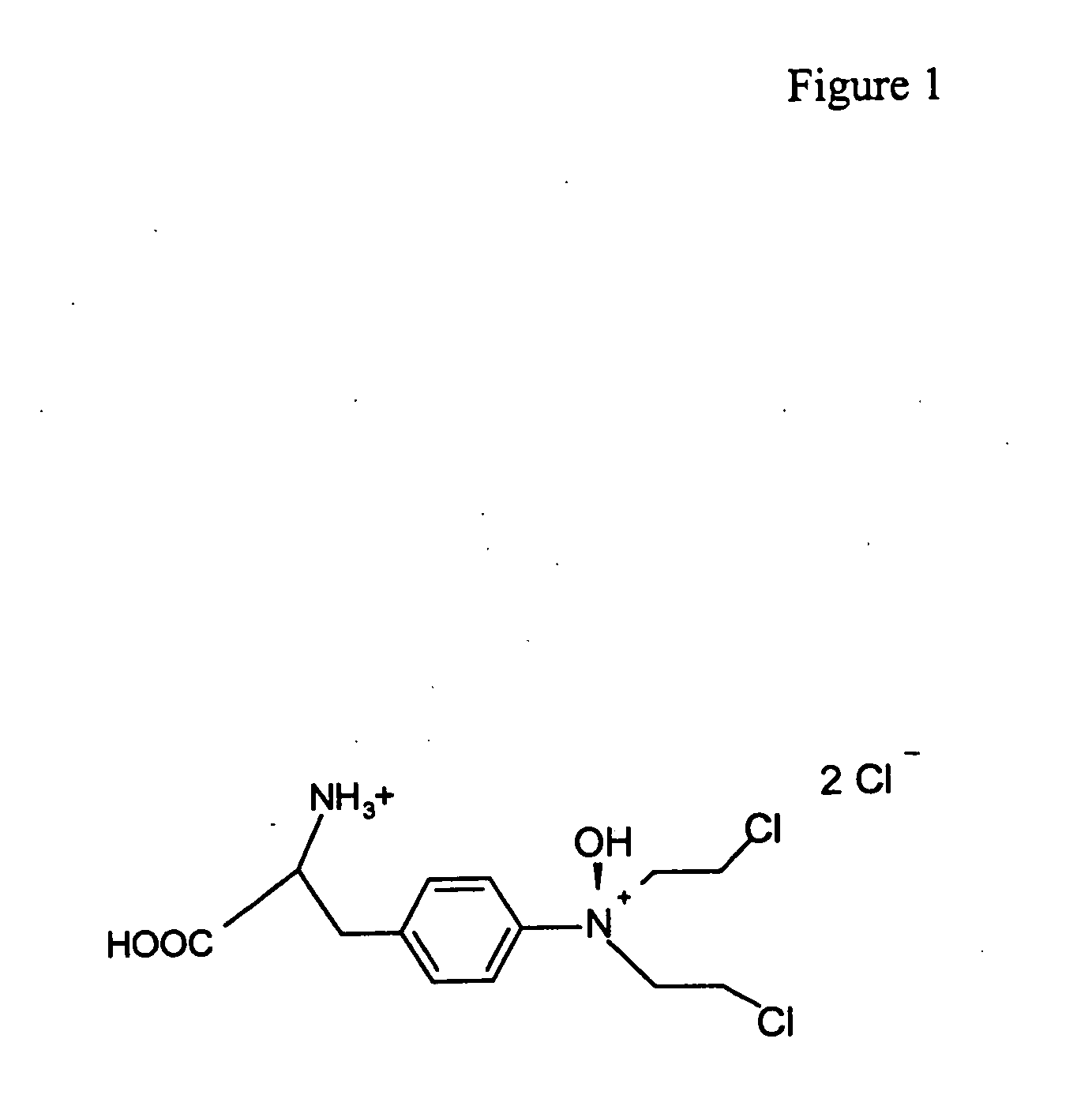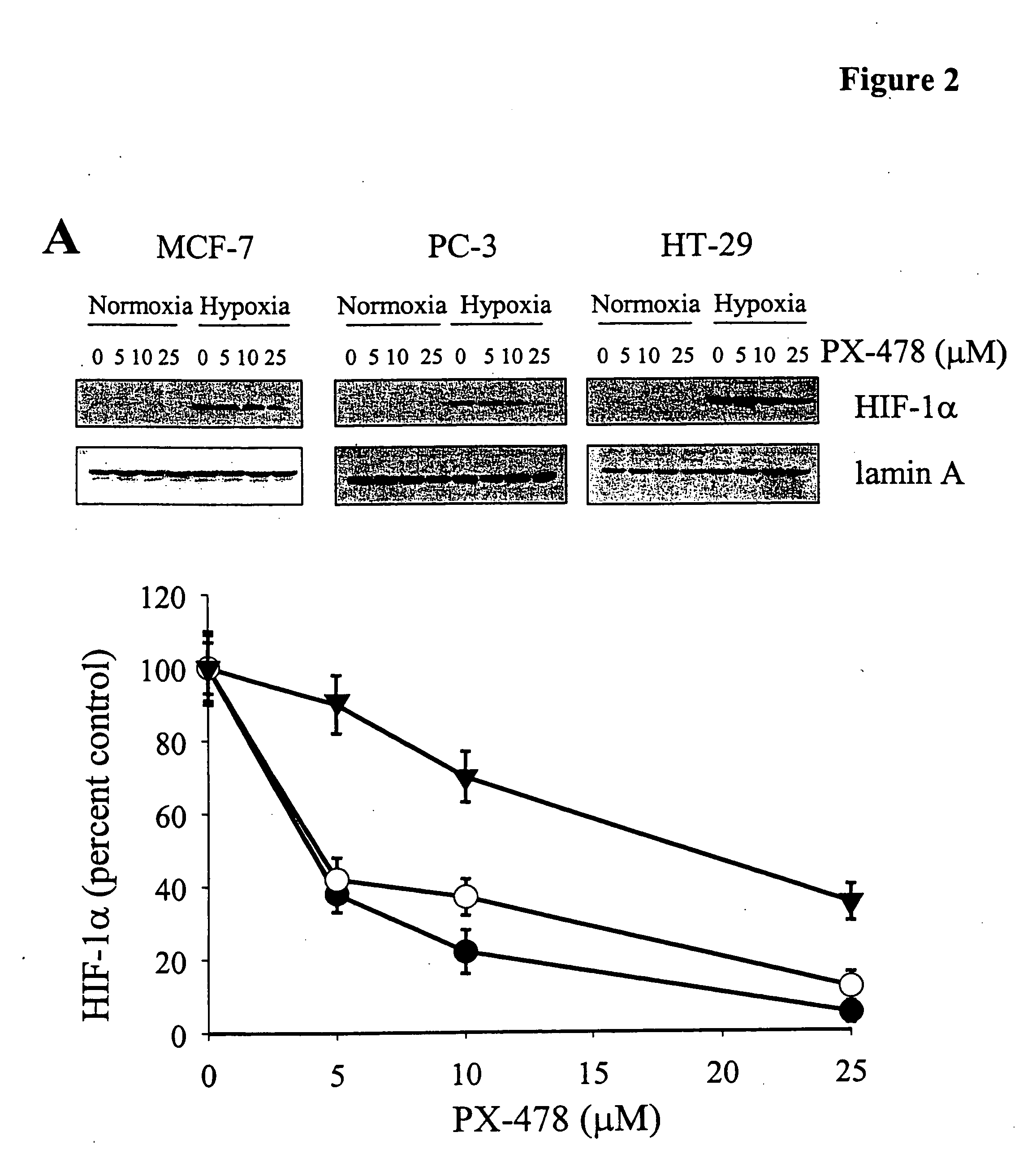Regulation of HIF protein levels via deubiquitination pathway
a ubiquitination pathway and hif technology, applied in the field of compounds, compositions and formulations of noxides and derivatives thereof, can solve the problems of not teaching or suggesting the use of all n-oxides as effective inhibitors of hif-1 or angiogenesis, and the regulation of hif levels through the ubiquitin/26s proteasome pathway has not been proposed before, so as to increase the ubiquitination of hif-1, the ubiqui
- Summary
- Abstract
- Description
- Claims
- Application Information
AI Technical Summary
Benefits of technology
Problems solved by technology
Method used
Image
Examples
example 1
PX-478 Inhibits HIF-1αProtein and HIF-1 Signaling
[0073] In FIG. 2, human breast cancer MCF-7, colon cancer HT-29, and prostate cancer PC-3, under hypoxic conditions were treated with PX-478. A. Human breast cancer MCF-7, colon cancer HT-29 and prostate cancer PC-3 cells were treated for 16 hours with various doses of PX-478, as indicated, under normoxic (20% oxygen) or hypoxic (1% oxygen) conditions. Nuclear extracts were prepared and HIF-1α protein levels were examined using Western blotting (top panel). Blots were quantitated using Image Quant (lower panel). Lamin A was used as a loading control. B. MCF-7 cells were exposed to hypoxia (H) for 16 hours in the presence of 25 M PX-478, drug was washed out and recovery of HIF-1α levels under conditions of hypoxia was examined after the times indicated using Western blotting on nuclear extracts. Cells were also treated for 16 hours under normoxia (N) or hypoxia (H), in the absence of PX-478, as controls. Lamin A was used as a loading ...
example 2
PX-478 Does not Affect the Nuclear Localization of the HIF-1α HIF-1 Heterodimer in Hypoxic Cells
[0076] In FIG. 3, human breast cancer MCF-7, colon cancer HT-29, and prostate cancer PC-3, under hypoxic conditions were treated with PX-478. A. HT-29 cells were treated as indicated with PX-478 for 16 hour under normoxic (20% oxygen) or hypoxic (1% oxygen) conditions. HIF-1α levels were examined using Western blotting in nuclear and cytoplasmic fractions prepared from HT-29 cells treated with PX-478 under hypoxic conditions. PX-478 decreased HIF-1α levels in both subcellular fractions suggesting that PX-478 does not affect the nuclear import of the HIF-1α HIF-1 heterodimer in hypoxic cells. Nuclear and cytoplasmic extracts were prepared and HIF-1α levels were examined. B. HT-29 cells were treated for 16 hours under hypoxic conditions with or without 25M PX-478. Cells were fixed and permeabilized and HIF-1α protein was detected using immunofluorescence staining, confirmed that PX-478 doe...
example 3
Inhibition of HIF-1α is Associated with Increased HIF-1αDegradation and Ubiquitination
[0077] In FIG. 4, to determine whether PX-478 affects the breakdown of HIF-1α, PX-478 was co-incubated with the protein synthesis inhibitor cycloheximide during hypoxia treatment of HT-29 cells. A. HT-29 cells were treated with the protein synthesis inhibitor cycloheximide (40 M), PX-478 (25 M), or both, in hypoxia (1% oxygen). At the times indicated, nuclear cell extracts were prepared and HIF-1α levels were examined using Western blotting. Lamin A was used as a loading control. B. HT-29 cells were pulse-labeled with [35S]-cysteine / methionine and chased in unlabeled medium for the indicated times. For PX-478-treated samples, PX-478 was added to the chase medium. C. HT-29 cells were exposed to PX-478 as indicated under normoxia (20% oxygen) or hypoxia (1% oxygen). Nuclear cell extracts were prepared, and HIF-1α and hydroxylated HIF-1α levels were examined using Western blotting. D. HT-29 cells wer...
PUM
| Property | Measurement | Unit |
|---|---|---|
| Dimensionless property | aaaaa | aaaaa |
| Weight | aaaaa | aaaaa |
| Cell angle | aaaaa | aaaaa |
Abstract
Description
Claims
Application Information
 Login to View More
Login to View More - R&D
- Intellectual Property
- Life Sciences
- Materials
- Tech Scout
- Unparalleled Data Quality
- Higher Quality Content
- 60% Fewer Hallucinations
Browse by: Latest US Patents, China's latest patents, Technical Efficacy Thesaurus, Application Domain, Technology Topic, Popular Technical Reports.
© 2025 PatSnap. All rights reserved.Legal|Privacy policy|Modern Slavery Act Transparency Statement|Sitemap|About US| Contact US: help@patsnap.com



